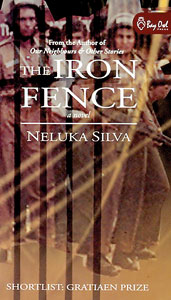Maybe it is time to think about the JVP uprising of 1987. I say that as an outsider. I have no business telling Sri Lankans what they should or shouldn't be thinking about. But it strikes me that there is an opportunity here. The war with the LTTE has been over for more than two years now. Sri Lankan is emerging into a new era. And yet, the past lingers here. The memories are still strong.
 |
There is plenty of unfinished business. When the JVP took to the streets in an attempt to overthrow the government by force, it was during a time when Sri Lanka had much to deal with—too much to deal with. The society was already being ripped apart by ethnic violence. The Indian Army had landed in the North, ostensibly as a peacekeeping force, but a potential threat to the sovereignty of Sri Lanka. The economic policies of the Jayewardene era were creating stress at every level of Sri Lankan life. Most Sri Lankans know the history much better than I do. I am just reminding you. It was a lot to deal with.
It is not very surprising, then, that the tendency in Sri Lanka has sometimes been to try to forget, to move on, to put the past in the past and leave it there. Unfortunately, this is often a difficult thing to do. Memory has a way of resurfacing, even when you least expect it. The repressed experiences of a former era come bubbling into the present like magma through the cracks and crevices of the earth's surface.
In Neluka Silva's novel, The Iron Fence, it is an iron fence that becomes the historical talisman stirring up old memories and reviving feelings from an almost-forgotten past. The iron fence is a fence that surrounds the university. The university is an mportant place in this story.
The JVP insurrection was, after all, an insurrection dominated by young people and university students. Silva's novel begins with one of those young people fifteen years after the fact. The character's name is Roshini. She finds herself, by accident and in the course of a normal day and its chores, outside the iron gates of the university during a student demonstration in 2002. She sees a face through the gates of the iron fence, the face of a student in a tussle with the police. And that experience erases the fifteen years that have transpired, bringing the present into direct contact with the past. Silva writes, "the face of the boy took her back to a time she'd tried so hard to forget; it took her back to regrets she ran away from, that she had pretended did not exist as the mediocrity of everyday life took over."
The rest of The Iron Fence is the unravelling of those memories, the unearthing of those regrets from the past. All the stories that had seemed to be buried come back to the surface again. This is something we know that literature can do. It can revive the past in the form of stories. Proust proved this long ago, that novels can have the almost miraculous capacity to reach back into the past and retrieve time that might otherwise have been lost. In the case of Silva's novel, the story of one young man in particular is pulled out from the obliteration of the past. His name is Senaka. Senaka stands in for so many of the young men who were lost in the violence that was unleashed by the JVP uprising. He comes from a typical Sinhalese village.
 |
| Neluka Silva |
Having shown promise in his local school, he is admitted to university. He arrives in Colombo and struggles with the reality of the big city, with relating to the English-speaking elite to be found there. A love affair finally takes him across class divisions. And then the crisis of the JVP uprising blasts everything apart. His life is churned up in the historical firestorm.
He disappears. Senaka's story serves to redeem the stories of many young men and women who, to this day, remain nameless. The young men and women who died in that violence or who simply disappeared from the streets and from their homes as the government attempted to quell the insurrection have been erased from the story of Sri Lanka. So it is in The Iron Fence; we never find out exactly what happened to Senaka.
Neluka Silva's book, to its credit, has no political agenda. Politics is a minefield, as everyone knows. There is always some danger in reviving the past here, since the past can come back to bite you.
But this is where fiction can be so helpful. The stories of individual human beings in their daily struggles can never be reduced to this or that political position. Silva, wisely, concentrates on just those individual stories in her novel. She lets the stories come first. She lets the characters be human beings. The Iron Fence is as much a love story as it is a story about historical upheaval. It is a family narrative far more than a narrative about politics. In that sense, The Iron Fence is a step forward.
No one doubts the importance of politics, in Sri Lanka or anywhere else. But human lives are not defined exclusively by politics. They cannot be and they shouldn't be. The stories of the JVP era should be allowed to live and breathe as part of the Sri Lankan narrative, as part of the story that is – for better or worse – the story of this country. If the stories of the past cannot live and breathe, it becomes very difficult for the stories of the present to live and breathe too. A nation can, like a person, begin to suffocate. Literature can sometimes play the role of an oxygen delivery system.
Neluka Silva does not solve the problems of politics in her novel. She does not pronounce upon the justice or foolishness of the JVP and its goals. She leaves those things alone in her quest to make human beings flesh and blood again. Individual lives that have been erased are able to come back and take their rightful place at the table. In telling the stories of Sri Lanka, in all their scattered and sometimes repressed fragments, in The Iron Fence Sri Lanka itself is being put back together and slowly made whole.
Morgan Meis has a PhD in philosophy from The New School for Social Research and writes for The Virginia Quarterly Review. He is a recipient of an Andy Warhol Foundation Award for his art criticism. He was a moderator at the Galle Literary Festival 2012. |



